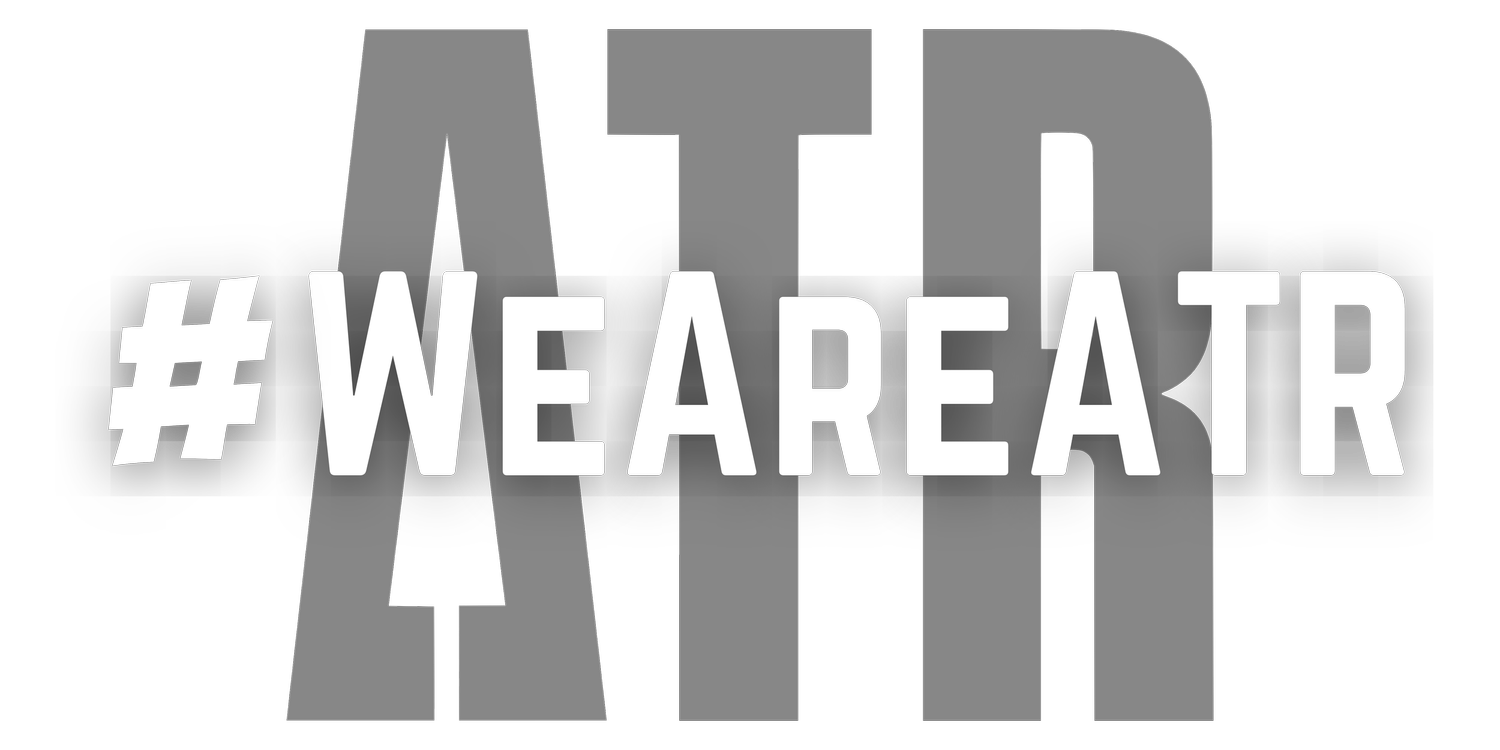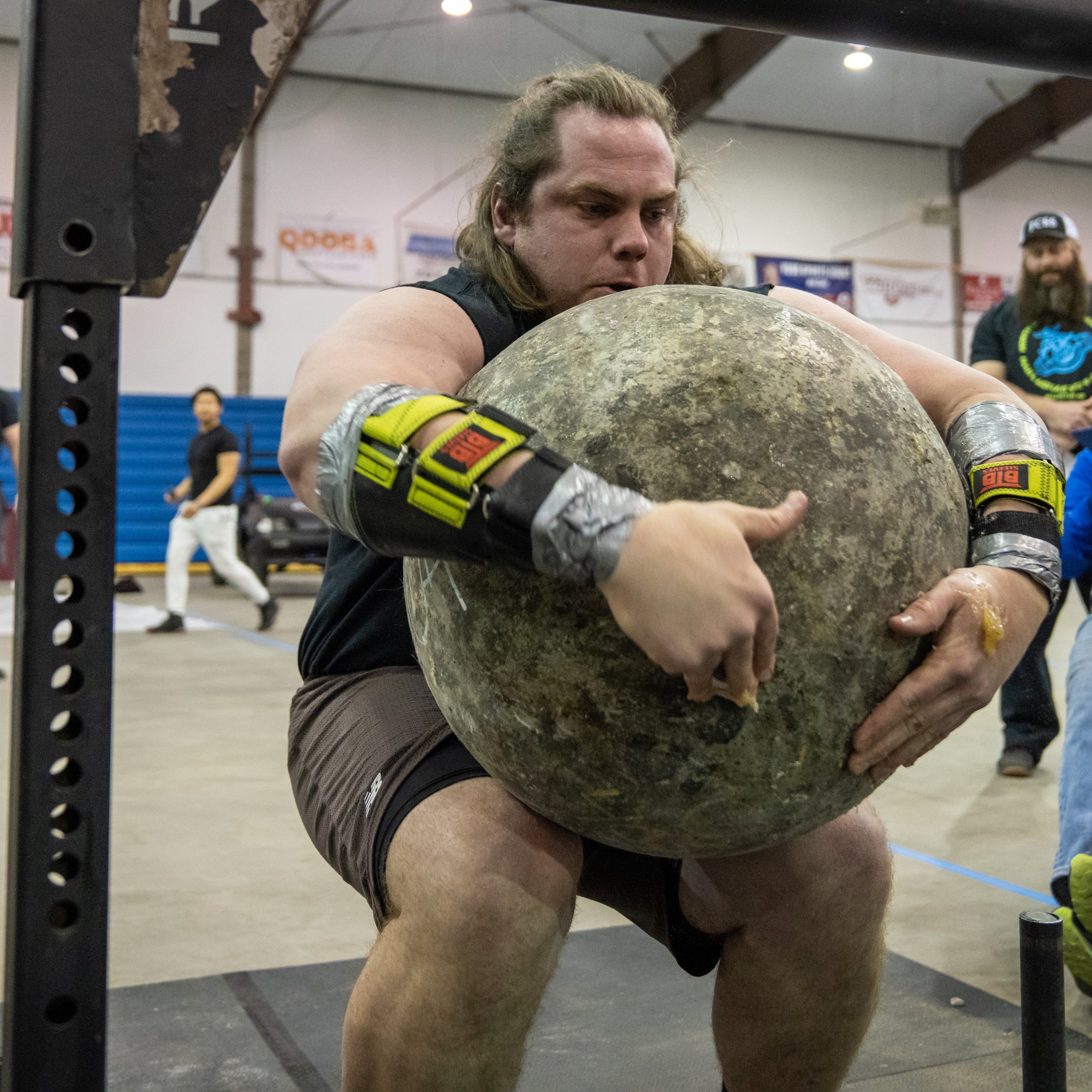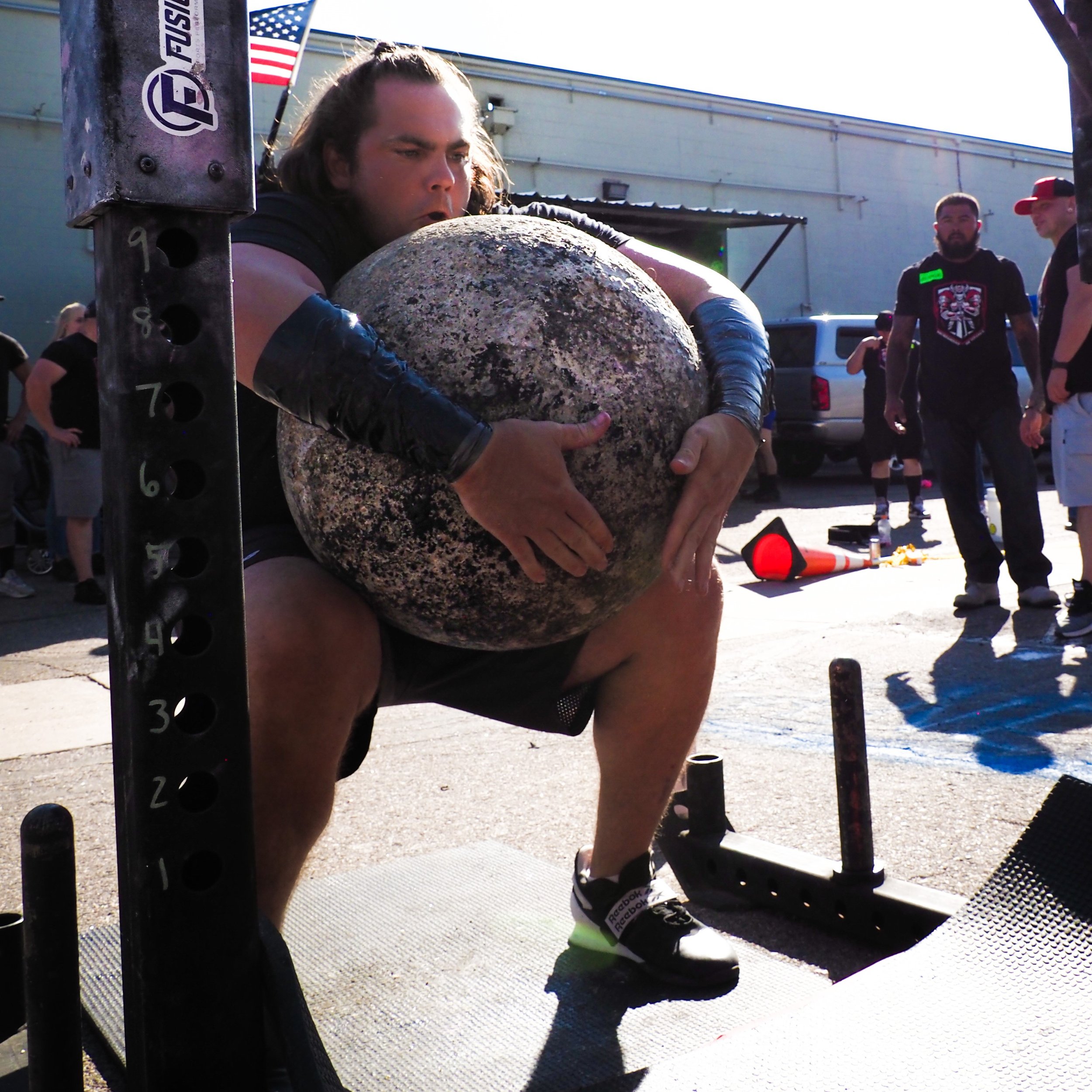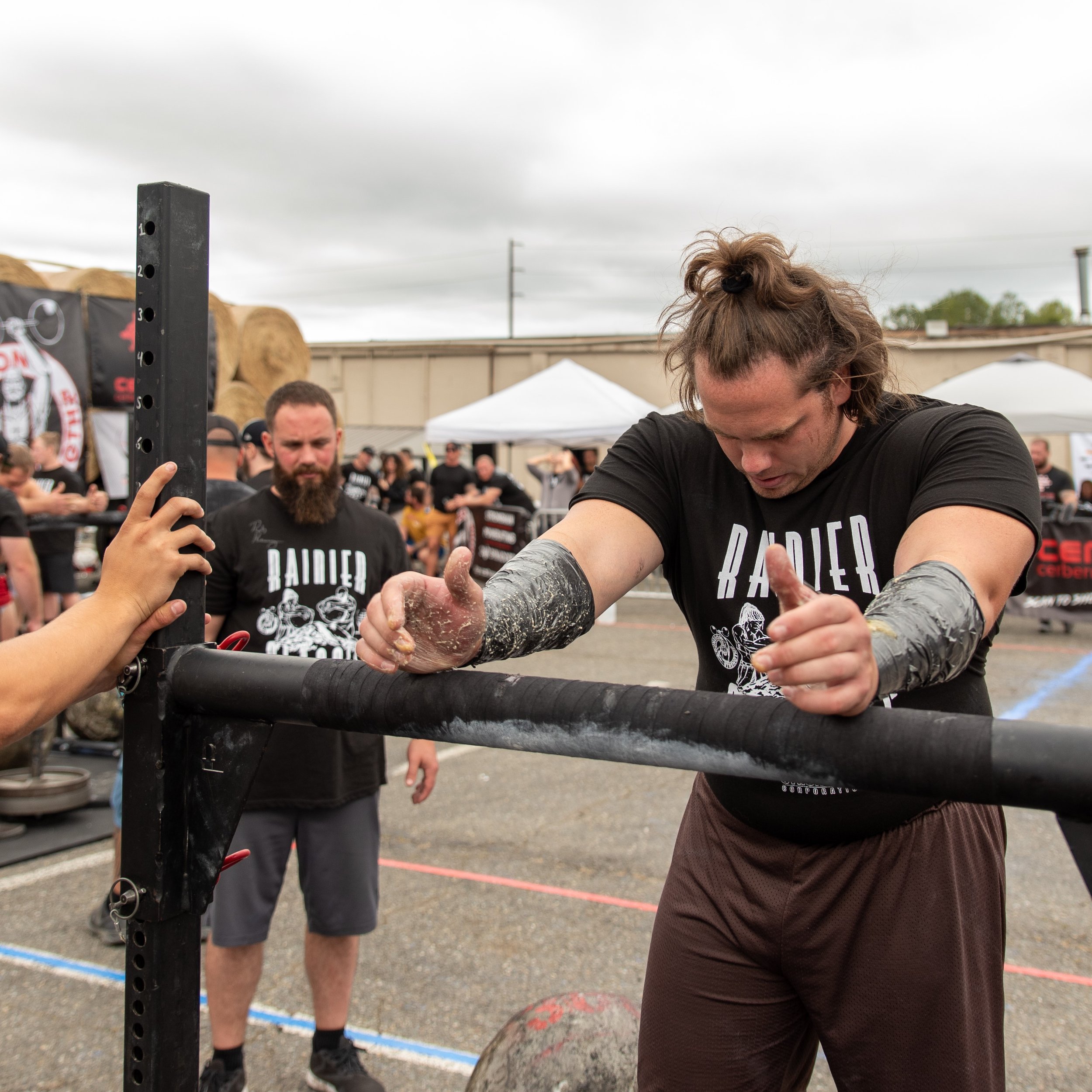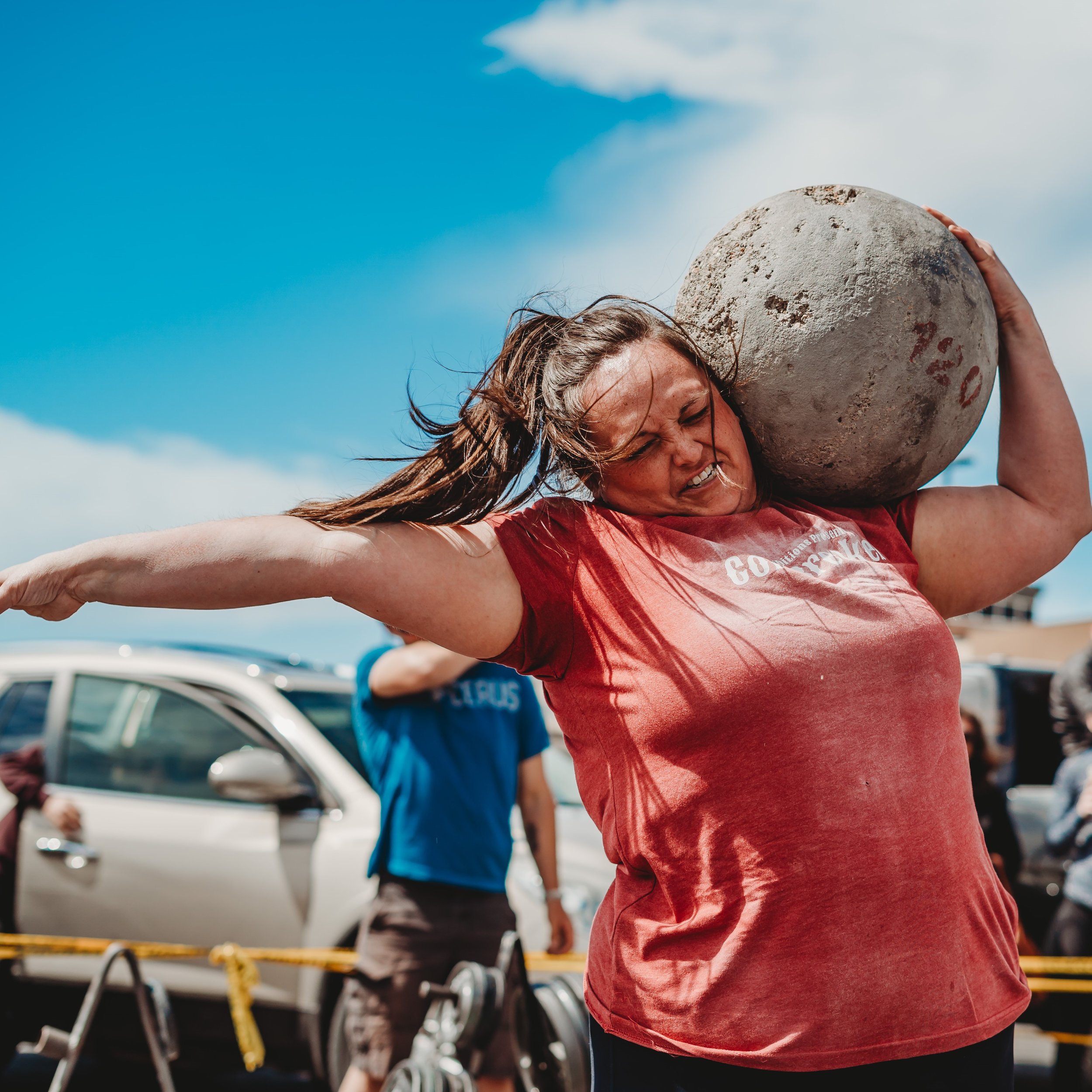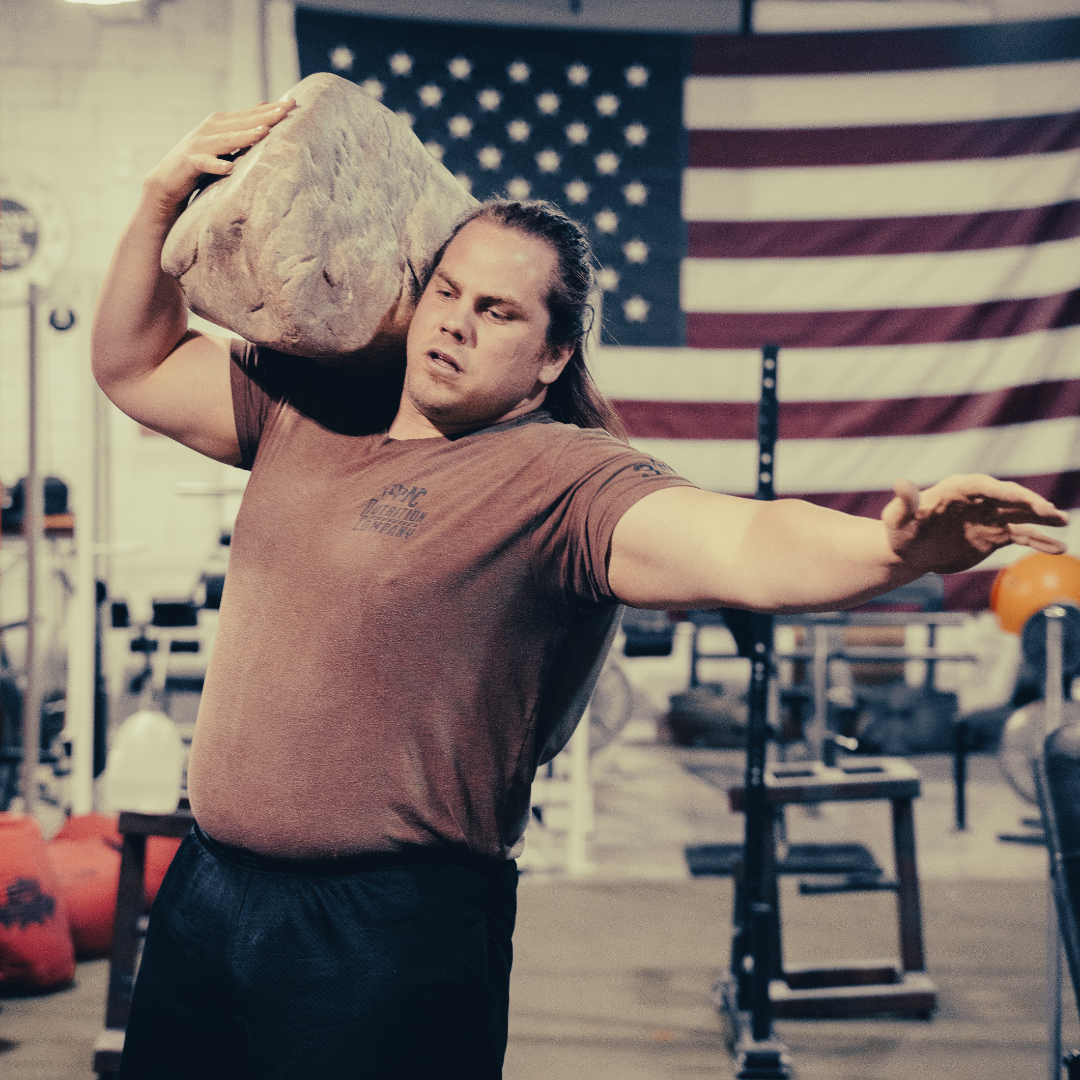Everything You Need To Know About Atlas Stone Events
The Atlas Stones are the best Strongman implement there is. There is no better feeling than taking a mass of concrete, tearing it from the ground, and hoisting it up high into the air for points.
Atlas Stones are an iconic staple of the sport and make their way into a lot of competitions in some form or fashion. They can seem intimidating at first but fear not, because in this post I’ve touched on just about everything you need to know about Atlas Stones and the events you’ll see in the competition.
If you’re new to the sport and have a stone event coming up, take careful notes so that you can look like a pro on the day of the contest.
Types of Atlas Stone Events
The Atlas Stones are best known as loading implements, but they’ve also been adopted for other events as well. In this section I’ll run you through all of the different events you’ll likely see in a competition.
Atlas Stone Loading Events
As I said, Atlas Stones are best recognized as a loading event. When the highlight reels of World’s Strongest Man show up, there is almost always a shot of one of the pros straining to get a stone out of their lap.
This is probably the most common event that you’ll see stones used for, and so we’ll cover it first and with the most depth.
Atlas Stone Series
An Atlas Stone Series is a dream event for most competitors… or at least for me. The event involves a number of different stones presented in some sort of order, and the winner of the event is the athlete that can load the most stones in the shortest time.
You see these a lot at big pro shows because of how much drama and excitement they can elicit. Oftentimes the athletes will go head-to-head in a race to the finish, and sometimes it’s the last event of the day and the podium will be decided by who wins that race!
They’re a little bit rare to see at smaller local shows. The Atlas Stone Series requires a lot of stones, and it requires some sort of bar or platform for each of those stones. Accumulating the equipment and getting it to the venue can be tough for smaller promoters.
One common theme that you’ll see with these events is the incremental weights. The series will typically start with light stones and end with heavy ones.
The apparatus to which the athletes load the stones will be the main difference from one show to the next. Some promoters will have individual platforms for each stone, and if so they’ll usually start tall and get shorter from stone to stone. Others will have a long bar or log that you’ll load the stones over, so the height will remain the same for the whole series. If the promoter wants to, he or she can mix and match the loading apparatuses as well.
The number of stones you’ll have to load can also differ from event to event. If you see a Stone Series posted, a safe assumption is that they’re implying 5 stones, but that is not always the case. At the Strength Island competition put on by World’s Ultimate Strongman back in March of 2021, they had an epic 10-stone series!
Plus you could always end the stone series with max reps on the last stone. This forms a blend of the Stone Series and Max Reps Atlas Stone events and could lead to any number of stones being loaded.
Max Reps
This is a pretty common event to see at smaller shows when promoters want to incorporate the Atlas Stones. There will be a set amount of time, usually 1 minute, given to the athlete to hit as many reps as possible. These events are easiest to facilitate by having athletes load over a bar.
One easy setup to make this event happen is to just use a Yoke and load the stones over that yoke. The thing to remember is that you may not be allowed to use the yoke to your advantage in getting the stone over the bar. Inadvertent touches should always be fine, but you may lose the credit for a rep if you grab the yoke to try and row your body through to help with the stone.
One of the main things that can vary from competition to competition is the height of the bar you’re loading over. The height of the bar can vary anywhere from just under 4’ to closer to 6’, but typically the height is right around 4’ if you see this event in the competition. At ATR, our go-to heights are 48” for women and 52” for men.
The other thing that will vary is the weight of the Atlas Stone that you’ll need to lift. It will largely depend on the weights that the promoter has available. That means that if the promoter doesn’t have a huge variety of stones, multiple weight classes might have to battle it out on the same size Atlas Stone. The other thing it will depend on is the number of reps that the promoter wants to see happen at the show. If he or she wants to see the athletes at the top of the weight class hit 2-5 reps, then it’s going to be very heavy. If they want to see the athletes at the top of the class hit 8-10, it will probably be lighter.
Last Man Standing
This event is a sort of max reps event, but with a different format. Your goal in this type of event will be to hit as many reps as possible, regardless of time. You’ll stand opposite another competitor at the bar, loading the stone back and forth until someone can’t get another rep. If there are multiple athletes in the division, the next athlete will step up and the loading will continue.
Once the stone hits the ground on your side of the bar, you’ll have a set amount of time to get your next rep. If the Atlas Stone doesn’t land on the other side of the bar in that amount of time, you’re out.
The athletes are ordered based on their placing going into the event. It could be based on the competition overall or the event that went right before, but you’ll have whoever is in last place loading stones first, and whoever is in first place loading stones last.
When there is only one athlete left, they will usually get a longer time to load the stone since they’re not having to wait on another athlete.
These events aren’t my favorite for local competitions. If the stone is even a little too light, they can go on forever with reps numbering what you’d expect from a Crossfit Competition. I love seeing this event at the pro level though, because even if it does go on for a bit, there is always some drama between the athletes as they dig deep for reps at the end of their run.
You’ll sometimes see this style of Atlas Stone Event as a tiebreaker, too. That is the ultimate in excitement. It becomes a battle of the heart when two athletes have to put everything on the line.
Atlas Stone to Shoulder
After loading events, the next most common event you’ll see involving the Atlas Stones is the Stone to Shoulder event. For this event, you’ll take the stone from the ground and heave it up to your shoulder and demonstrate control by removing one hand from the stone. You’ll see athletes have to shoulder Atlas Stones in a few different events.
Max Reps
This is the most common and simplest form of the Stone to Shoulder event. You’ll have a set time to get as many good reps as possible. You’ll have to get the stone to your shoulder and demonstrate control on each rep, and the rep will only count once the judge has given you the command to drop it.
Usually, the timer is set for anywhere between 60 and 90 seconds. The weight of the stone will be determined based on the equipment constraints of the promoter and their desired number of reps from the athletes.
Atlas Stone to Shoulder Series
The idea here is similar to a stone-loading series. Participants will have a number of different stones lined up in a row that they will have to shoulder to complete the event. The score will either be based on the number of reps you get or the time it took you to complete all of the stones in the series.
I haven’t seen this event much, but what I have seen has been 4-5 stones. Right now in Strongman the Sandbag to Shoulder event is very popular, so I don’t think it’s crazy to think that we’ll see the Atlas Stone to Shoulder Event start popping up more often.
Medley Event
A medley is an event with multiple different implements. The Stone to Shoulder can be part of a medley with other implements all taken to shoulder, or even just stand alone with other events that could seem unrelated.
I love this idea and really hope to incorporate it into a future show we host through ATR, but I haven’t seen it come up in a competition just yet.
Other Things Worth Noting
I’ve covered the bulk of what you’ll see, but when it comes to Atlas Stone Events, there are a few peripheral things that I feel are worth mentioning.
Trump Event
You can see this variation in both the Stone to Shoulder and Atlas Stone Loading events.
The promoter will pick out two weights for the event, one is typically much heavier than the other. A single good rep with the larger implement will be scored higher than any number of reps with the smaller implement.
For example, when we hosted Colt Breakers in April of 2022, we had a Trump Stone to Shoulder event. Each participant had two stones to choose from and 60 seconds to hit as many reps as possible. We had a couple of athletes just hit 1-2 reps with the larger implement and other athletes hit 5-10 on the smaller implement. The athletes that hit the 1-2 reps with the larger implement still placed higher even though they got fewer reps overall.
A Trump Stone Event can be really fun when the larger of the two stones is either some sort of a record or just a super heavy stone for that show. The first time I ever hit a 400lb stone it was the larger stone in a Trump Stone event, and the only other competitor to lift it was the guy that beat me.
Stone Pressing
Stone Pressing is one of the coolest things a Strongman can do, but it isn’t something that shows up in competition often. I believe there are two key reasons for that. The first is that it is inherently unstable and dangerous. The second is that the weights you’ll see for a press event don’t even come close to the weights athletes are capable of for an Atlas Stone Loading or Stone to Shoulder Event.
You will see stone pressing at higher levels from time to time, but it is still pretty rare.
Natural Stones
We have to be careful to distinguish between Atlas Stones and Natural Stones when we talk about stone events. Atlas Stones are perfect spheres, making it easier to find incremental weights and regulate the technique you’ll use to load them.
Natural Stones are brought to the event exactly as they were found in the wild, so they have awkward shapes and textures that you’ll have to strategize around at the moment.
Usually, if you see Natural Stones in a competition, it’ll be a Stone to Shoulder Event or a Stone Press event.
Atlas Stone Tacky
No discussion of Atlas Stones can be had without a discussion about Stone Tacky. Usually, we think of the goop that Strongman are applying to their hands and forearms to help them grip the stone when it is so large that they can barely get their arms around them. That isn’t the only form of tacky that you need to know about for Strongman.
There will be a number of different stone events where that goop won’t be legal. In those events, you may be able to get away with different forms of tacky that won’t be quite as good as the goop, but are still better than going at it raw.
The Goop
In the early days of Strongman, athletes all had their own way of making tacky, or at least they knew someone with a great product. Nowadays there are multiple companies producing high-quality Stone Tacky that you can purchase.
Different Types of Goop
Different companies have different recipes, and each athlete will have their preferences. Usually what changes from company to company is the consistency and malleability of the tacky itself.
Within each company, there are also different grades of tacky. When the tacky gets hot it starts to turn to liquid and run. Once it's gotten to this point it won’t do you any good when you go to lift the stones. If the tacky is too cold, it will turn hard as a rock, and you won’t be able to work it. The different grades of tacky are meant to maintain their ideal consistency at different temperatures.
Cerberus makes 4 grades of tacky, each one corresponding with a different temperature that you might be asked to compete in. This is my favorite brand so far, and the main grade that we use here in the gym is Grade 2. We’ll bust out the Grade 3 for hot competition days, and sometimes the Grade 1 if the gym gets really cold in the winter.
I still haven’t seen their new Grade 4, but I have a feeling that conditions will have to be pretty toasty to warrant busting that out.
Applying the Tacky
You can tell a beginner Atlas Stone Lifter by the amount of tacky they apply to themselves.
More is not necessarily better. You just need enough.
I will usually punch two fingers into the tacky and scoop out a bead, breaking it loose from the rest with my thumb. This will be enough to attack a set of Atlas Stones.
The tacky becomes easier to work with as it gets warm, so you want to work it in your hands as you spread it. Eventually, you’ll want a thin coating on your hands and the bulk of the inside of your forearm.
If I think that I have a chance at hitting more than 4 or 5 reps, I’ll put a spare bead of tacky on the back of my hand or forearm somewhere. That way I can reapply if necessary and I don’t have to try to wrestle the jar in the middle of the event.
Clean Up
Getting the tacky off requires a bit of know-how. Soap and water isn’t going to cut it.
A lot of companies sell tacky remover now, and some people still try to use baby oil, but I find that the best thing to remove the tacky is either WD-40 or some form of Contractor’s solvent.
You use it the same way that you’d use soap. Just get some in your hands and start working it into the tacky. Once your hands are starting to feel like the sticky is wearing off, you can grab a rag and wipe your hands. Don’t use a paper towel or anything that might tear. If you still have some tacky on your hands that you haven’t hit with the solvent, it’ll grab at the paper towel and make the mess even worse.
Once you’ve got it all off, you’re good to wash your hands like normal and go on about your day.
Spray Tacky
A lot of times the goop won’t be legal, but you’ll still be allowed to use tacky in some other form. Your options include using either a spray tacky, or tacky towels. Here is the rundown on both.
Spray Tacky for Other Sports
Spray tacky has been around for a while in other sports. Golf and tennis are both sports where it's used to keep a grip on their implement. When it comes to Atlas Stone Events, it can give you a little extra grip when compared to going in with just your bare arms.
The thing about spray tacky is it doesn’t last very long. You’ll feel the extra grip for one rep, maybe two, before it’s gone and you’re on your own. That means that it is good if you’re thinking you’re only going for a single stone lift.
We’ve experimented with all sorts of different sprays, but just about anything you use only lasts one rep. There are some that barely last that long.
Our Experience at ATR
You can search spray tacky on Google or Amazon and find all sorts of products. Everything that we’ve used here at ATR has worked equally well, so in my opinion, it is pretty tough to go wrong.
One thing that we’ve been experimenting with is using floor adhesive as a spray tacky. It comes in bigger quantities and is a bit stronger than classic spray tacky, I just can’t comment on how safe it is.
Tacky Towels
Tacky towels are literally towels saturated with a light tacky. Whatever you touch with the towels will receive a little bit of tacky.
Each towel has a relatively short lifetime. You’ll only get a few reps worth of tacky out of each one, and you’ll have to reapply it after each rep. It’s definitely more cumbersome than the goop, but you can use it strategically because you can carry them with you into an event.
If you have an Atlas Stone event that allows for a tacky towel, but not regular tacky, can get a good application of tacky before your run, and then reapply between stones midway through if necessary.
Pairing some spray tacky with a handful of tacky towels can be huge to get you through Stone Loading events.
Stone Sleeves
The concrete of the Atlas Stone is rough and abrasive and can damage the skin of your forearms as you work with the stones. Even if you can tough it out, eventually the pain will have an impact on your performance, so I highly recommend using a protective layer around your arms, or a set of stone sleeves.
There are a few different kinds that are currently working for athletes in Strongman.
Tape Sleeves
The easiest, cheapest and most accessible form of Stone Sleeve is the one made out of tape.
Duct Tape
If I don’t have my stone sleeves, duct tape is what I like best around my forearms. I also think it is the most common thing that you’ll see at shows because it's cheap, it's easy, and it works fairly well.
One hack that I would recommend you take advantage of is spraying a little tacky onto your bare arm before the duct tape goes on. As you sweat under the tape it’ll start to lose its grip on your arm and slide around.
Another tip when you use duct tape is to layer it. As you wrap the tape around your arm, try to get at least half of the prior wrap under the current one. As you lift the stones with tacky, the coils of tape around your arm will want to spread apart, and every gap that you get in your tape is going to leave you with tacky-less bare skin.
Other Types of Tape
A few other types of tape have started to become popular in the sport, but I haven’t tried any of them. If you’re interested in one of these products, I recommend firing off a DM to the athlete you saw wearing them asking for their opinion. Try to see what they like about that tape, and how they would compare it to duct tape.
The one type of tape that I have used is athletic tape, and I wouldn’t recommend it. It’s just not sticky enough to hold up to the pull of Atlas Stones with tacky on them. It’s more expensive and doesn’t work as well as duct tape.
Bare Skin
The last option is to forego a sleeve altogether and just use your bare arm. There are a lot of athletes that like this method, but I don’t personally recommend it. While training for a stone series event my duct tape sleeve kept falling apart before I could get all my reps in, so I tried bare skin.
You can probably adapt to it, but the friction of the concrete Atlas Stone will wear on the inside of your forearm and it can get pretty painful. I found that it limited the amount of work I could do overall in my stone sessions.
If you do decide to go bare-skinned, I recommend shaving your arms and getting a lot of practice with it before competition day.
Manufactured Atlas Stone Sleeves
There are a few companies out there that are manufacturing stone sleeves for purchase that you can strap on. They’re usually made of some sort of leather and have adjustable straps around them.
Stone sleeves are far superior to tape or bare skin, especially if you’re going to be loading multiple stones in a single event. You don’t have to worry about the stones tearing apart your tape or tearing up your arms.
My only experience with Atlas Stone Sleeves is the BTB stone sleeves, and I’m a huge fan. These sleeves are rigid, so they don’t fold when you stick them to the stone with tacky and lift. Once secured at either end with a little duct tape, they don’t slide up or down on the arm under load.
BTB is based out of the UK, so you spend a little more and wait a little longer to get them. The reason I went with BTB anyway is because of the insane amount of customization they offer. They ask for three different measurements of your forearm to make sure that they fit you perfectly, and then you also have a lot of color combinations to choose from.
What to Wear to Lift Atlas Stones
What you wear for stones should matter. They are concrete spheres that tear up your skin and clothing, so you’ll want to give some thought to what you plan on wearing. Here are some options and some things to think about.
Bring Your Own Shirt
Most competitions that will allow the use of tacky will also allow you to bring your own shirt. Getting a competition t-shirt is standard in Strongman, and promoters don’t want to ask you to tear up your brand new shirt at their stone event.
I recommend keeping a couple of old shirts in your back specifically for Atlas Stone Loading. You’ll want these shirts to be 100% cotton and have something on the front that isn’t super slick. Most screen-printed or heat-pressed shirts will have a relatively sticky design on them, but you don’t want to make things harder on yourself by going with something that doesn’t have any bite.
These shirts aren’t going to have a long life, so make sure there is little to no sentimental value.
Grip Shirts
Grip shirts are also typically allowable, but for events with tacky, I’m not sure how much they help. If you have a good t-shirt that has a decent design on the front, you should have everything that you need without having to risk your nice grip shirts.
If you’re doing an event that doesn’t allow for tacky, they shouldn’t get beat up too bad and they can really help as you try to climb the body with the stone.
No Shirt
When a stone is covered in a thick layer of tacky, sometimes that tacky can grab your shirt as you’re trying to get the stone to leave your torso and cause you issues. If you’re loading a stone to a platform and your shirt gets stuck to the stone, you’ll have to wrestle yourself free from the stone before you can move on in the series.
Some athletes also feel that they can’t keep their stone from slipping on a shirt and that they get better traction from going without.
The problem is that Atlas Stones can be rough! Especially once they start to wear and dust, Atlas Stones can build up a hostile surface that can do a lot of damage to your skin. If you’re a guy, I would recommend at least shaving your chest so that any tacky on the stone doesn’t effectively wax it for you, and then make sure you’ve tried loading without a shirt before you get to the competition.
Shorts/Bottoms
You’ll have to have some sort of bottoms on, but I recommend you find the tightest fitting bottoms you can. Loose shorts can get stuck to the tacky of the stone and add resistance as you go to load. You want something that will stick to your body and not create extra difficulty for your rep. The stones will tear them up and leave them forever stuck with tacky, so don’t use anything you’re really tied to.
Best Practices at Competition
There are things about Atlas Stone events that nobody tells you before the competition, but that you pick up after doing a few shows with the events. They aren’t going to make or break your performance, they’re just housekeeping things that help to alleviate the stress of the promoters and volunteers.
It can be nerve-racking to host a competition with an Atlas Stone Event when you know that beginners might be using tacky for the first time. Here are a few things to note that will make you seem like a vet of the sport with the goop.
Bring Your Own Cleanup Supplies
Most competitions will have a small area with some sort of solvent out and available for athletes to use for cleanup. Inevitably after just a couple of divisions have gone through the stone event and they’re cleaning up, the area is a mess.
Bringing your own supplies and keeping the area clean is a very courteous way to show your appreciation for the meet promoter and the venue. I usually bring a bag of rags, WD-40, and some waterless handwash to the show in a separate bag from the rest of my gear.
There are plenty of promoters that have realized that when they put out a cleaning station it will inevitably become a huge mess and they skip it. They’ll just ask that athletes bring their own cleanup supplies. Regardless its always a good idea to bring a small stash of your own to every competition.
Don’t touch anything once you’ve got your tacky on
You will have tacky on whatever you touch once you’ve applied it with your hands. Rookies at shows will inevitably apply tacky way early, sometimes as soon as the prior event is over. Then they walk around for a while getting tacky all over everything.
Try to put off actually applying the tacky for as long as you can so that you minimize how long you have to avoid contact with things. Then once you have it on, go find somewhere to sit down where you’re not going to risk getting the tacky everywhere.
Strongman promoters all want to bring you the best venue that they can for the competition, but they are always going to be responsible for keeping it clean. The first time that a promoter has to work the place over with a bunch of rags and some WD-40, they’re unlikely to do it again. Save the tacky for the Atlas Stones once you’ve got it on your hands and arms.
Ask about Designated Areas for Application
A lot of promoters will have a very specific place that they’ve allocated specifically for the application and removal of tacky. Usually, this will be announced in the lifter’s meeting before the lifting begins, but if not be sure to ask.
You might be fully capable of applying your tacky like an adult wherever you want without making a mess, but nothing elevates stress levels for a promoter quite like having people running around all over the place with tacky. Ease your promoter’s mind by utilizing the space as they designed and keeping everything clean.
Conclusion
Atlas Stones are my favorite event, but there is a little bit of know-how required to be able to go into a show and make the most of it. You’ll want to make sure you know exactly what your Atlas Stone event looks like and how its scored, then you’ll want to make sure that you have all of the tools you need to be successful.
Hopefully, this post can serve as a sort of reference for you as you compete in your first few Atlas Stone events. If this helped you I hope you’ll tag me in your event videos!
